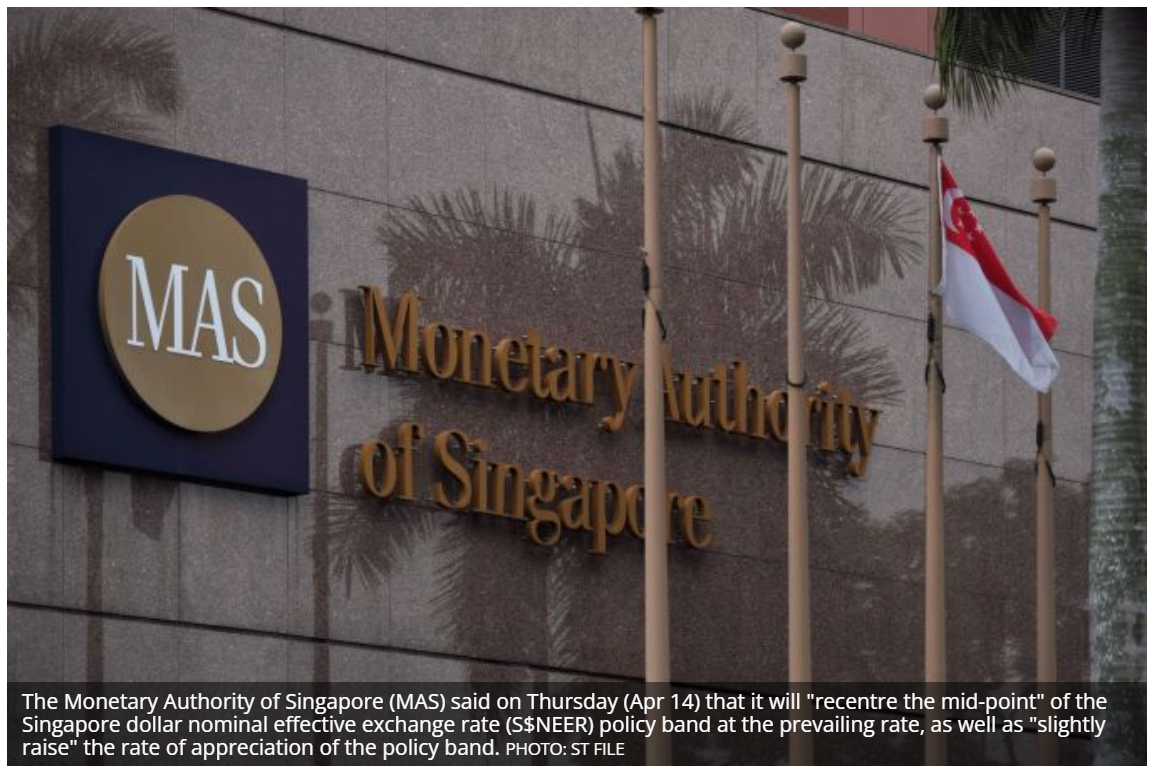Singapore: MAS takes more aggressive ‘double-barrelled’ move to tighten monetary policy, raises inflation forecast
SINGAPORE’S central bank is taking a more aggressive approach to further tighten its monetary policy settings in 2 ways, while also raising its inflation forecast, citing fresh shocks to global commodity prices and supply chains that are adding to domestic cost pressures.
The Monetary Authority of Singapore (MAS) said on Thursday (Apr 14) that it will “recentre the mid-point” of the Singapore dollar nominal effective exchange rate (S$NEER) policy band at the prevailing rate, as well as “slightly raise” the rate of appreciation of the policy band. There is no change to the width of the policy band.
This is according to its latest monetary policy statement, which is typically published twice a year.
In the last 6 months, however, MAS moved to raise the slope of the band twice amid rising inflation, including an off-cycle move in January that surprised the market.
“The fresh shocks to global commodity prices and supply chains are adding to domestic cost pressures and will bring MAS core inflation to a significantly higher level than its historical average through 2022. Underlying inflationary pressures remain a risk over the medium term,” MAS said.
Accordingly, the central bank raised its core inflation forecast to 2.5 to 3.5 per cent this year, from its January projection of 2 to 3 per cent.
It is also expecting headline inflation to reach 4.5 to 5.5 per cent, compared with the earlier range of 2.5 to 3.5 per cent.
“This tighter monetary policy stance, which builds on the policy moves in October 2021 and January 2022, will slow the inflation momentum and help ensure medium-term price stability,” MAS added.
Shortly after MAS’s announcement, the Singapore dollar rallied against the US dollar to 1.3551 by 8.35 am.
Still, MAS’s latest move was not altogether outside of economists’ expectations, several of whom had warned of a possible “double-barrelled move” amid rising inflation, although most of them had penciled a steepening of the S$NEER slope as their base case.
“Admittedly, the recentring move was a tad more aggressive than our base case for recentring higher but below the prevailing S$NEER, but is consistent with price shocks,” said Vishnu Varathan, head of economics and strategy for Asia and Oceania at Mizuho.
Inflation had in recent months hit near-decade high levels, with Russia’s invasion of Ukraine worsening the energy crisis and already-tight supply chains.
Headline inflation for January and February rose to 4.2 per cent, up from 3.7 per cent in the fourth quarter last year; core inflation, which excludes accommodation and private transport, was 2.3 per cent for the same period, increasing from Q4’s 1.7 per cent.
On Thursday, the central bank warned that inflation is likely to increase by “more than previously anticipated” in the quarters ahead, due to “sharply higher” global commodity prices since late February and renewed supply chain disruptions arising from the Ukraine war and the Covid-19 pandemic.
“The latest surge in energy and agricultural commodity prices will raise domestic inflation for electricity and gas, fuel and non-cooked food over the year. In turn, these will feed into higher transportation and food services costs,” said MAS.
Strong pent-up demand for discretionary expenditure could also lead to greater pass-through of accumulating business costs, MAS said, noting that the resident unemployment rate has declined to its pre-crisis level and is expected to remain low.
“While incoming non-resident workers would alleviate manpower shortages, the overall labour market will remain tight and keep resident wages well supported. The resulting unit labour cost increases will be a key source of underlying inflation,” said MAS.
Meanwhile, gross domestic product (GDP) rose 0.4 per cent on a quarter-on-quarter seasonally adjusted basis in Q1, slowing down from the 2.3 per cent expansion in Q4, according to advance estimates by the Ministry of Trade and Industry.
MAS said the slowdown was “largely anticipated” and driven by weaker activity in the manufacturing and modern services sectors, which had posted strong outturns in the previous quarter.
While global GDP growth was strong in early 2022, overall prospects for the global economy are “uncertain and hinge on the evolution of the conflict and regional pandemic situation”, it said.
“Nevertheless, at this juncture, aggregate demand growth in Singapore’s major trading partners is expected to ease somewhat but not be derailed given the buffer provided by savings and wealth accumulated in recent years,” said MAS.
Against this backdrop, Singapore’s trade-related and modern services sector should expand more slowly this year compared to 2021, although the recovery in the domestic-oriented and travel-related sectors should “gather pace” with the relaxation of Covid-19 measures, it added.
Economists said this may not be the last time the central bank is raising the S$NEER slope this year, given the “significant” upward revision to its inflation forecast.
“We forecast further tightening this year by increasing the slope by another 0.5 percentage points. We do not rule out the possibility of this happening earlier than October if price pressures continue to be substantially strong in the near term,” said Priyanka Kishore, head of India and South-east Asia economics at Oxford Economics.
Mizuho’s Varathan said MAS joins a group of central banks that have taken a more hawkish stance by front-loading its tightening.
“The so-called ‘Kokomo Club’ of central banks that aim to ‘get there fast, and then take it slow’ necessarily are inclined to front-load tightening, with a 50 basis point hike as a hallmark,” he said, adding that the Bank of Canada and the Reserve Bank of New Zealand are “core” members of the club.
Source: https://www.businesstimes.com.sg/government-economy/mas-takes-more-aggressive-double-barrelled-move-to-tighten-monetary-policy


 English
English




